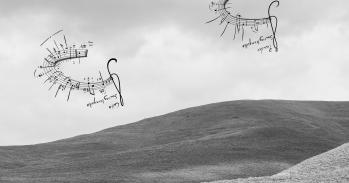An investigation into how musicians find creative inspiration has identified four key ingredients needed for creative expression. It also shows that musicians may be at their most inspired when they step away from their instruments and think about music in different ways.
An investigation into how musicians find creative inspiration has identified four key ingredients needed for creative expression. It also shows that musicians may be at their most inspired when they step away from their instruments and think about music in different ways.
Exploration and experimentation without the instrument itself may be an important part of how musicians learn and become creative
John Rink
Artists of any description are well-acquainted with the search for an elusive muse, but for musicians in particular, help may now be at hand. In a new study, reported today, researchers examining creativity in music-makers have put forward fresh insights into how musicians “find” their creative voice.
The results may come as a surprise - not least because they suggest that musicians may be at their most creative when not actually playing or singing. The study found that breakthrough moments of inspiration often took place while they were humming pieces to themselves, imagining dance moves or emotional narratives inspired by the music, or tapping out rhythms on nearby furniture, rather than using their instruments.
If that sounds like an open invitation to shower-singers and air-guitarists, however, the researchers, from the University of Cambridge, also found four main ingredients needed for an artist to achieve creative expression in practice and performance contexts alike. These are: freedom, flexibility, a sense of being “in the moment”, and a commitment to “giving” the music to an audience - even if that audience exists only in their imagination while they are rehearsing, or even just thinking about performing.
The project is one of the major research initiatives launched in 2009 by the Centre for Musical Performance as Creative Practice, a collaboration between the Universities of Cambridge and Oxford, King’s College London, and Royal Holloway, and funded by the Arts and Humanities Research Council. The work of the Centre is reported in a new film, “Passionate about Performance,” released online today, the fourth anniversary of CMPCP's launch.
“One of the aims of the Centre was to research how musicians develop creatively, and how they can be supported and enabled as they undertake this all-important process,” John Rink, Professor of Musical Performance Studies at the University of Cambridge, and the Centre’s Director, said. “Some of our discoveries thus far may feed into a performance curriculum allowing students to aspire to - and attain - greater musical inspiration and creative individuality than they already achieve.”
Although creativity itself is the subject of widespread scholarly research, not many studies have examined creativity in musical performance. Those that have looked at it have generally been conducted from the perspectives of musicologists, theorists and composers, rather than that of performers themselves.
Furthermore, the researchers found that one of a number of barriers which limit musicians as they strive to find their creative voice is a sense that they need to respect the score that they are working from and the composer who wrote it. “There is a perceived hierarchy, in which the composer is deemed to be of much greater importance than the ‘mere’ executant,” Rink added. “This can be compounded by too much emphasis being placed by performers themselves on the acquisition of technique in its own right rather than coupled with deep, creative engagement with the music.”
Rink himself led the project called “Creative learning and ‘original’ music performance”, which set out to explore how creativity and originality can be fostered in performing musicians as they learn and refine their art in the practice room and teaching studio as well as on stage.
The team, which included two postdoctoral researchers, Dr Mirjam James and Dr Karen Wise, carried out fieldwork at the Guildhall School of Music & Drama and the Royal College of Music. The two researchers used a combination of questionnaires, interviews, focus-group discussions, and observations of one-to-one lessons and practice sessions. Select students at both institutions were monitored as they practised towards an examination and a public performance over a period of weeks.
To gain access to the innermost thoughts of both students and teachers, the team also employed an innovative video-recall technique, which involved filming the one-to-one lessons and then asking each student and teacher to watch the films separately. In doing so, they were invited to identify moments when they felt especially creative in their playing or teaching, or when something new emerged about their understanding of a piece. These were described by the team as “creative episodes”.
Some students were also filmed practising on their own, and in addition they were asked to keep practice diaries as they prepared for their exams and public performances. The videos were, again, later played back to the student and their reflections on the film compared with the contents of the diaries.
The films include one session in which a horn student was undertaking private practice. When he watched the videos of his practising, the student identified 34 creative episodes - of which 23 took place while he was not using his instrument but instead was singing, whistling, playing the piano, and beating out the rhythm of the piece. Yet in 40 entries recorded by the same student in his practice diary, 28 pertained to the technical use of the instrument itself.
“During the ‘creative episodes’ that he identified he was doing all kinds of things to embed the music in his mind, but many of them were not directly related to his actual instrument,” Rink said. “Interestingly, he was not fully aware that this was happening. When textbooks talk about ‘mental practice’ they generally refer to thinking about how the instrument is used. Less emphasis is placed on thinking about the actual music or how it might be internalised. Yet, as this case shows us, exploration and experimentation without the instrument itself may be an important part of how musicians learn and become creative.”
The study also reports the experiences of a harpsichord student who had been a dancer in her childhood. Her breakthrough in one lesson came not while playing the harpsichord, but when she imagined different characters dancing to the piece. “When I played next week, it had an impact,” she told the researchers in an interview. “It was to do with the movement and gestures... When I think of that moment I can put myself back in the piece, it opens the door to where that piece lives, in my head.”
The researchers concluded that musicians begin to make a piece their own when they feel free and flexible enough to be spontaneous and take risks, and to trust themselves rather than simply rely on external validation from a teacher or others. Performers also consistently talked about “being in the zone” or in a “flow” state, suggesting that they also need to move beyond a normal form of consciousness - and as with the harpsichord player, this may emerge from and indeed require personal and private insight. Finally, the participants in the project consistently showed that they were at their most creative when they were playing to, or imagining, an audience, to whom they saw themselves “giving” the music and their performance.
The research team stress that, far from being a magic formula for unlocking creativity in performers, these, and their other conclusions, should be regarded as general guidelines for both students and teachers as they strive to become, or to nurture, better performers.
“By discovering for themselves key aspects of the creative process, the performers in our study have been able to reflect on what it is that makes them individually creative and to unlock more of that for themselves,” Rink said. “Although it was not our goal to change what anyone does, we have also been gratified to hear teachers who took part in our study say that they will approach their work differently, based on what they have seen and heard.”
In addition to their contribution to the film, the team have been presenting lectures and running workshops at different music schools and universities around the world, based on their research. With colleagues at the Guildhall School and RCM, they are also producing a book, Musicians in The Making - Pathways to Creative Performance, which Oxford University Press will publish in 2015.
Further information about the AHRC Research Centre for Musical Performance as Creative Practice can be found at: http://www.cmpcp.ac.uk/
Inset image: A music student who participated in the study is filmed while practising the horn
This work is licensed under a Creative Commons Licence. If you use this content on your site please link back to this page.





